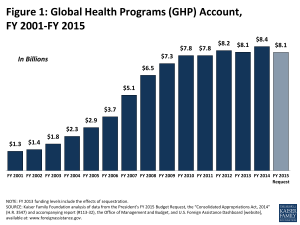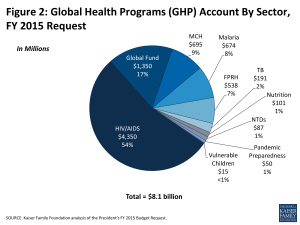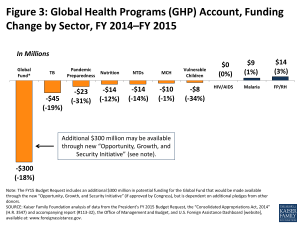The U.S. Global Health Budget: Analysis of the Fiscal Year 2015 Budget Request
Overview:
The President’s FY15 budget request, which was released on March 4, 2014, proposed $9.4 billion1 in funding for global health programs. If enacted, this would represent a decline of approximately $350 million (-4%) from levels set in the FY14 Omnibus Appropriation and would essentially be a return to FY13 post-sequestration funding amounts.2
Most of the global health budget ($8.1 billion) specified in the FY15 budget request is provided through the Global Health Programs (GHP) account at USAID and the State Department (see Figure 1 & Figure 2). Within the GHP account, all programs would decline, with the exception of funding for malaria and Family Planning and Reproductive Health (FP/RH), which would both increase slightly; funding for bilateral HIV, through PEPFAR, would remain flat (see Figure 3). The FY15 budget request includes $1.35 billion as the base U.S. contribution to the Global Fund to Fight AIDS, Tuberculosis, and Malaria (Global Fund), which is $300 million below the FY14 level and would account for a significant share of the total decline in global health funding, although this is in large part due to legislative restrictions on the U.S. contribution to the Global Fund (see Global Fund section below).3 Funding for tuberculosis (TB) efforts would represent the second largest decrease (-$45 million), followed by pandemic influenza (-$22.5 million) and nutrition (-$14 million).
The FY15 budget request includes a newly proposed “Opportunity, Growth, and Security Initiative” that would provide additional funding across many areas, including some for global health activities (e.g. for the Global Fund; see below). However, this new initiative, which proposes an additional $56 billion in discretionary funding (divided evenly between defense and non-defense), would be offset by mandatory spending reforms and higher revenues;4 it therefore, requires Congressional approval and remains uncertain.
If Congress approves the President’s FY15 Budget Request, global health funding would be impacted more than other areas when compared to broader budgetary trends, particularly when compared to final FY13 post-sequestration levels (see Table 1). For instance, while funding for global health would remain essentially flat between FY 13 and FY 15, funding for international affairs overall would increase by 7%.5 In addition, funding for all non-defense discretionary programs, of which global health is a part, would increase by 3%.6 In both FY13 and FY14, however, Congress approved higher funding levels for global health than those proposed in the President’s budget request. Whether or not Congress continues this trend remains to be seen.
The summary below provides an overview of global health funding levels by program area as proposed in the FY15 Budget Request (unless otherwise stated, all comparisons are to enacted FY14 levels).7
PEPFAR/Bilateral HIV:
PEPFAR’s bilateral HIV funding through the GHP account totaled $4,350 million ($330 million at USAID and $4,020 at the State Department) matching the FY14 funding level (Table 2), but more than $600 million below its peak level of $4,959 million in FY10. Bilateral HIV accounts for the largest share (54%) of the global health portfolio under the GHP account. The FY15 budget request for HIV includes funding for microbicides research ($45 million), U.S. contributions to IAVI ($28.7 million), the Commodity Fund ($20.3 million), and the Joint United Nations Programme on HIV/AIDS (UNAIDS) ($45 million).
The budget request also includes $375.9 million for HIV research activities at the National Institutes of Health (NIH) and $128.7 million in HIV funding through the Centers for Disease Control and Prevention (CDC); both totals match FY14 levels. Additional funding for HIV programs at the Department of Defense (DoD) is not yet known (in prior years, it has ranged between $8 and $10 million).
Global Fund to Fight AIDS, Tuberculosis and Malaria (Global Fund):
At the Global Fund’s 4th Replenishment Conference held in December 2013, President Obama announced that the U.S. would contribute $1 for every $2 pledged by other donors. The FY15 budget request proposes $1,350 million in base funding for the Global Fund towards fulfillment of this pledge.3 While base funding for the Global Fund is $300 million (-18%) below the FY14 level, the budget request includes an additional $300 million in potential funding that would be made available through the new “Opportunity, Growth, and Security Initiative” (if approved by Congress), but is dependent on additional pledges from other donors. The Global Fund accounts for the second largest share (17%) of global health funding (in the GHP account).
Tuberculosis:
Funding for TB through the GHP account totaled $191 million, a $45 million (-19%) decrease below FY14 and would be the lowest level of funding since FY09. TB funding, which includes funding for the TB Drug Facility ($13.5 million), represented the second largest decrease (after the Global Fund) among all areas under the GHP account. Additional tuberculosis funding provided through the Economic Support Fund (ESF) account is not yet known (in prior years, it has ranged between $8 and $20 million).
Malaria:
Malaria funding totaled $674 million in the FY15 budget request and was one of only two program areas under the GHP account (the other being family planning & reproductive health) that increased above FY14 levels ($9 million or 1%). The budget request also includes $150.7 million for malaria research activities at NIH and $10.7 million in malaria funding through the CDC; both totals match FY14 levels. Additional malaria funding through DoD is not yet known (in prior years, it has ranged between $8 million and $30 million).
Family Planning & Reproductive Health (FP/RH):
FP/RH funding totaled $538 million and was one of only two program areas under the GHP account (the other being malaria) that increased ($14.1 million or 3%) from FY14 levels. The FY15 budget request also included $35.3 million for the U.S. contribution to the United Nations Population Fund (UNFPA), essentially matching the FY14 level ($35.0 million).8 Additional FP/RH funding provided through other accounts such as the Economic Support Fund (ESF) is not yet known.
Maternal & Child Health (MCH):
In the FY15 budget request, MCH funding through the GHP account totaled $695, a decrease of $10 million (-1%) below FY14 levels. This includes $495 million in funding for bilateral programs and a $200 million contribution to GAVI. Some additional MCH funding provided through other accounts, such as the ESF and Food for Peace (FFP) accounts, is not yet known. The FY15 budget request states that additional MCH funding would be provided through the new “Opportunity, Growth, and Security Initiative” (if approved by Congress), but does not specify an amount. Specific components of MCH funding include:
- GAVI: The U.S. contribution to GAVI, which is included under MCH funding in the GHP account, totaled $200 million, a $25 million (14%) increase above FY14.
- Polio: U.S. funding for polio programs is provided through USAID (as part of MCH funding via the GHP and ESF accounts) and CDC. Polio funding through the CDC totaled $161 million, a $10 million (7%) increase above FY14 levels; with the exception of new funding ($45 million) for the recently launched “Global Health Security Initiative” (see below) polio is the only area in the CDC global health budget that increased in the FY15 budget request. Polio funding through the GHP and ESF accounts at USAID is not yet known.
- United Nations Children’s Fund (UNICEF): The U.S. contribution to UNICEF totaled $116.6 million in the FY15 budget request, a $15.4 million (-12%) decrease below FY14.8
Nutrition:
Nutrition funding in the request through the GHP account totaled $101 million, a $14 million (-12%) decrease below FY14. Additional nutrition funding provided through other accounts, such as the ESF and FFP accounts, is not yet known.
Vulnerable Children:
Funding for vulnerable children, which is provided via the Displaced Children and Orphans Fund (DCOF), totaled $14.5 million in the GHP account, a $7.5 million (-34%) decrease below FY14. The decrease in funding for vulnerable children was the largest percentage decrease among all areas under the GHP account.
Pandemic Preparedness:
Pandemic Preparedness funding through the GHP account totaled $50 million, a decrease of $22.5 million (-31%) below FY14. The decrease in pandemic preparedness funding was the second largest percentage decrease among all areas under the GHP account. Additional funding provided through other accounts, such as the ESF account, is not yet known.
Global Public Health Protection:
The FY15 budget request for CDC includes $100.3 million in funding for Global Public Health Protection, of which $45.5 million is for Global Disease Detection and Emergency Response, $9.8 million is for Global Public Health Capacity Development, and $45 million is new funding to support the Global Health Security Initiative, a new effort launched in February 2014 aimed at improving global capabilities to prevent, detect, and respond to epidemics and other emerging public health threats.
Other Global Health Funding:
The U.S. provides additional global health funding in support of water, sanitation and hygiene (WASH) activities, for international global health research efforts conducted through the Fogarty International Center (FIC) at NIH, and for multilateral organizations, such as the World Health Organization (WHO) and the Pan American Health Organization (PAHO), that play an important role in addressing global issues. The FY15 budget request proposes $67.8 for international global health research activities at FIC ($0.2 million or 0.3% above FY14), a $114 million contribution to WHO ($4.2 million or 4% above FY14), and a $66.5 million contribution to PAHO ($0.4 million or 0.6% above FY14); U.S. funding for WASH activities is not yet known.
Other Non-Global Health Funding:
The FY15 budget request also proposed funding for areas and agencies that are not directly focused on U.S. global health, but are related and may impact these efforts including: the Millennium Challenge Corporation (MCC), Feed the Future (FtF), which is the U.S. Government’s Global Hunger and Food Security Initiative, broader food assistance through Food for Peace (FFP) and McGovern-Dole International Food for Education and Child Nutrition (McGovern-Dole), and other funding through the State & Foreign Operations Development Assistance (DA) and ESF accounts. Within the budget request, funding for the MCC ($1,000 million) increased by more than $100 million (11%) above FY14 enacted levels, while funding for McGovern-Dole remained flat and funding for FtF and FFP declined – FtF declined by approximately $100 million (-9%) and FFP declined by $66 million (-4.5%) (see Table 3). The FY15 budget request proposes additional funding through the new “Opportunity, Growth, and Security Initiative” (if approved by Congress) for the MCC ($350 million) and Feed the Future (additional amount not specified).
Endnotes
This total represents funding amounts specified in the Department of State, Foreign Operations, and Related Programs FY 2015 Congressional Budget Justification, the National Institutes of Health FY 2015 Congressional Justification, and the Centers for Disease Control and Prevention FY 2015 Congressional Justification. Additional funding for some global health programs at USAID and DoD are not yet available.
Total known FY15 funding is $82 million (<1%) above FY13 post-sequestration levels. Of the $82 million increase, $45 million would support the recently launched Global Health Security Initiative at the CDC.
By law, U.S. contributions to the Global Fund may not exceed 33% of total contributions from all donors. During a hearing on the budget request held on March 12, 2014 before the State, Foreign Operations, and Related Programs Subcommittee of the House Committee on Appropriations, Secretary of State Kerry stated that the U.S. was acting to fulfill its pledge based on the existing commitments of other donors.
See "Budget of the United States Government, Fiscal Year 2015," White House Office of Management and Budget (OMB), March 4, 2014.
The International Affairs total represents funding through the Function 150 account only and does not include funding for Overseas Contingency Operations (OCO) (see “FY 2015 Congressional Budget Justification – Department of State, Foreign Operations, and Related Programs”).
Discretionary funding levels are adjusted (and rounded) baseline totals (see summary tables in “Budget of the United States Government, Fiscal Year 2015,” released by the White House Office of Management and Budget (OMB) on March 4, 2014).
Unless otherwise specified, all totals refer to funding amounts under the GHP account. All comparisons are to FY14 levels.
U.S. funding for UNFPA and UNICEF is provided through the International Organizations and Programs (IO&P) account.



